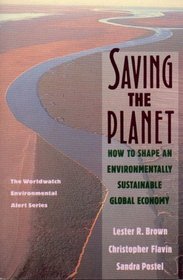This book attempts to provide a realistic path toward using renewable energy and responsible industry. It is well foot-noted and scholarly. Published in 1991, it is a little out of date, but given the somewhat dismal progress the world has made, it isn't as bad as it seems. The book is divided into 13 chapters:
1 - Uncover the Lifeboats - which paints a grim picture for the future of planet Earth.
2 - The Efficiency Revolution - looks at the cost of transportation and how damaging and inefficient current fuel sources are.
3 - Building a Solar Economy - introduces the idea of relying purely on renewable energy and how its use will create jobs.
4 - Reusing and Recycling Materials - tries to call to light the inefficiencies of the current packaging methods.
5 - Protecting the Biological Base - shows how much trouble the environment is in.
6 - Grain for Eight Billion - presents a plan for efficient agriculture using the land we already have available.
7 - A Stable World Population - makes the case for reducing the number of children people have, especially in industrialised countries.
8 - From Growth to Sustainable Progress - details examples of economic reforms needed to put plans into action.
9 - Better Indicators of Human Welfare - tries to show that GNP is not the best indication of welfare and urges the reader to look at disease rates and environmental quality.
10 - Reshaping Government Incentives - explains present and future government programs.
11 - Green Taxes - proposes a carbon tax.
12 - Banking on the Environment - analyses the investment:return ratio of spending money on the environment.
13 - The Struggle for a New World - predicts the challenges that would be faced in bringing these policies to fruition.
The book is well-written with concrete examples, but obviously follows its own dogma and pays little attention to alternative arguments. That isn't to say it is a bad book. It just is quite biased toward its own solutions.
1 - Uncover the Lifeboats - which paints a grim picture for the future of planet Earth.
2 - The Efficiency Revolution - looks at the cost of transportation and how damaging and inefficient current fuel sources are.
3 - Building a Solar Economy - introduces the idea of relying purely on renewable energy and how its use will create jobs.
4 - Reusing and Recycling Materials - tries to call to light the inefficiencies of the current packaging methods.
5 - Protecting the Biological Base - shows how much trouble the environment is in.
6 - Grain for Eight Billion - presents a plan for efficient agriculture using the land we already have available.
7 - A Stable World Population - makes the case for reducing the number of children people have, especially in industrialised countries.
8 - From Growth to Sustainable Progress - details examples of economic reforms needed to put plans into action.
9 - Better Indicators of Human Welfare - tries to show that GNP is not the best indication of welfare and urges the reader to look at disease rates and environmental quality.
10 - Reshaping Government Incentives - explains present and future government programs.
11 - Green Taxes - proposes a carbon tax.
12 - Banking on the Environment - analyses the investment:return ratio of spending money on the environment.
13 - The Struggle for a New World - predicts the challenges that would be faced in bringing these policies to fruition.
The book is well-written with concrete examples, but obviously follows its own dogma and pays little attention to alternative arguments. That isn't to say it is a bad book. It just is quite biased toward its own solutions.





